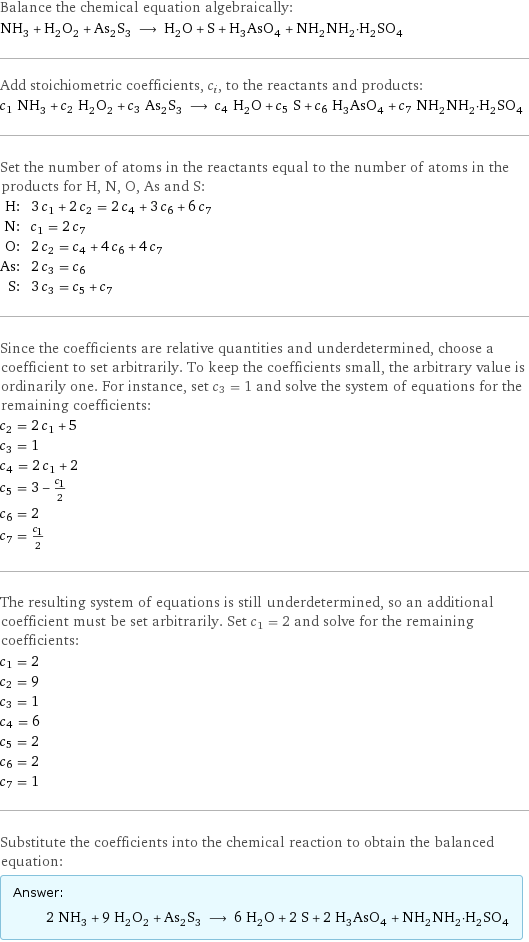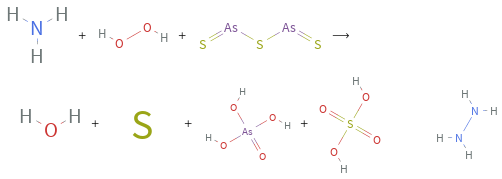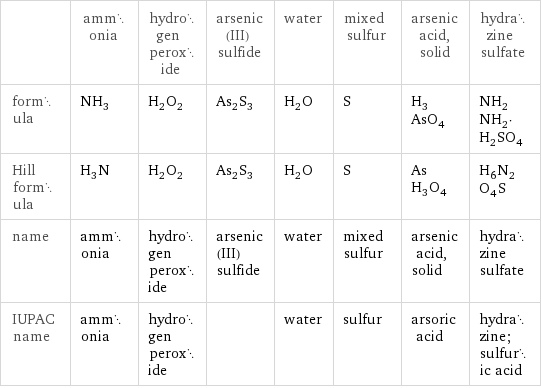Input interpretation

NH_3 ammonia + H_2O_2 hydrogen peroxide + As_2S_3 arsenic(III) sulfide ⟶ H_2O water + S mixed sulfur + H_3AsO_4 arsenic acid, solid + NH_2NH_2·H_2SO_4 hydrazine sulfate
Balanced equation

Balance the chemical equation algebraically: NH_3 + H_2O_2 + As_2S_3 ⟶ H_2O + S + H_3AsO_4 + NH_2NH_2·H_2SO_4 Add stoichiometric coefficients, c_i, to the reactants and products: c_1 NH_3 + c_2 H_2O_2 + c_3 As_2S_3 ⟶ c_4 H_2O + c_5 S + c_6 H_3AsO_4 + c_7 NH_2NH_2·H_2SO_4 Set the number of atoms in the reactants equal to the number of atoms in the products for H, N, O, As and S: H: | 3 c_1 + 2 c_2 = 2 c_4 + 3 c_6 + 6 c_7 N: | c_1 = 2 c_7 O: | 2 c_2 = c_4 + 4 c_6 + 4 c_7 As: | 2 c_3 = c_6 S: | 3 c_3 = c_5 + c_7 Since the coefficients are relative quantities and underdetermined, choose a coefficient to set arbitrarily. To keep the coefficients small, the arbitrary value is ordinarily one. For instance, set c_3 = 1 and solve the system of equations for the remaining coefficients: c_2 = 2 c_1 + 5 c_3 = 1 c_4 = 2 c_1 + 2 c_5 = 3 - c_1/2 c_6 = 2 c_7 = c_1/2 The resulting system of equations is still underdetermined, so an additional coefficient must be set arbitrarily. Set c_1 = 2 and solve for the remaining coefficients: c_1 = 2 c_2 = 9 c_3 = 1 c_4 = 6 c_5 = 2 c_6 = 2 c_7 = 1 Substitute the coefficients into the chemical reaction to obtain the balanced equation: Answer: | | 2 NH_3 + 9 H_2O_2 + As_2S_3 ⟶ 6 H_2O + 2 S + 2 H_3AsO_4 + NH_2NH_2·H_2SO_4
Structures

+ + ⟶ + + +
Names

ammonia + hydrogen peroxide + arsenic(III) sulfide ⟶ water + mixed sulfur + arsenic acid, solid + hydrazine sulfate
Equilibrium constant
![Construct the equilibrium constant, K, expression for: NH_3 + H_2O_2 + As_2S_3 ⟶ H_2O + S + H_3AsO_4 + NH_2NH_2·H_2SO_4 Plan: • Balance the chemical equation. • Determine the stoichiometric numbers. • Assemble the activity expression for each chemical species. • Use the activity expressions to build the equilibrium constant expression. Write the balanced chemical equation: 2 NH_3 + 9 H_2O_2 + As_2S_3 ⟶ 6 H_2O + 2 S + 2 H_3AsO_4 + NH_2NH_2·H_2SO_4 Assign stoichiometric numbers, ν_i, using the stoichiometric coefficients, c_i, from the balanced chemical equation in the following manner: ν_i = -c_i for reactants and ν_i = c_i for products: chemical species | c_i | ν_i NH_3 | 2 | -2 H_2O_2 | 9 | -9 As_2S_3 | 1 | -1 H_2O | 6 | 6 S | 2 | 2 H_3AsO_4 | 2 | 2 NH_2NH_2·H_2SO_4 | 1 | 1 Assemble the activity expressions accounting for the state of matter and ν_i: chemical species | c_i | ν_i | activity expression NH_3 | 2 | -2 | ([NH3])^(-2) H_2O_2 | 9 | -9 | ([H2O2])^(-9) As_2S_3 | 1 | -1 | ([As2S3])^(-1) H_2O | 6 | 6 | ([H2O])^6 S | 2 | 2 | ([S])^2 H_3AsO_4 | 2 | 2 | ([H3AsO4])^2 NH_2NH_2·H_2SO_4 | 1 | 1 | [NH2NH2·H2SO4] The equilibrium constant symbol in the concentration basis is: K_c Mulitply the activity expressions to arrive at the K_c expression: Answer: | | K_c = ([NH3])^(-2) ([H2O2])^(-9) ([As2S3])^(-1) ([H2O])^6 ([S])^2 ([H3AsO4])^2 [NH2NH2·H2SO4] = (([H2O])^6 ([S])^2 ([H3AsO4])^2 [NH2NH2·H2SO4])/(([NH3])^2 ([H2O2])^9 [As2S3])](../image_source/81577ccffd7e9c07c77cf66c2e1edab6.png)
Construct the equilibrium constant, K, expression for: NH_3 + H_2O_2 + As_2S_3 ⟶ H_2O + S + H_3AsO_4 + NH_2NH_2·H_2SO_4 Plan: • Balance the chemical equation. • Determine the stoichiometric numbers. • Assemble the activity expression for each chemical species. • Use the activity expressions to build the equilibrium constant expression. Write the balanced chemical equation: 2 NH_3 + 9 H_2O_2 + As_2S_3 ⟶ 6 H_2O + 2 S + 2 H_3AsO_4 + NH_2NH_2·H_2SO_4 Assign stoichiometric numbers, ν_i, using the stoichiometric coefficients, c_i, from the balanced chemical equation in the following manner: ν_i = -c_i for reactants and ν_i = c_i for products: chemical species | c_i | ν_i NH_3 | 2 | -2 H_2O_2 | 9 | -9 As_2S_3 | 1 | -1 H_2O | 6 | 6 S | 2 | 2 H_3AsO_4 | 2 | 2 NH_2NH_2·H_2SO_4 | 1 | 1 Assemble the activity expressions accounting for the state of matter and ν_i: chemical species | c_i | ν_i | activity expression NH_3 | 2 | -2 | ([NH3])^(-2) H_2O_2 | 9 | -9 | ([H2O2])^(-9) As_2S_3 | 1 | -1 | ([As2S3])^(-1) H_2O | 6 | 6 | ([H2O])^6 S | 2 | 2 | ([S])^2 H_3AsO_4 | 2 | 2 | ([H3AsO4])^2 NH_2NH_2·H_2SO_4 | 1 | 1 | [NH2NH2·H2SO4] The equilibrium constant symbol in the concentration basis is: K_c Mulitply the activity expressions to arrive at the K_c expression: Answer: | | K_c = ([NH3])^(-2) ([H2O2])^(-9) ([As2S3])^(-1) ([H2O])^6 ([S])^2 ([H3AsO4])^2 [NH2NH2·H2SO4] = (([H2O])^6 ([S])^2 ([H3AsO4])^2 [NH2NH2·H2SO4])/(([NH3])^2 ([H2O2])^9 [As2S3])
Rate of reaction
![Construct the rate of reaction expression for: NH_3 + H_2O_2 + As_2S_3 ⟶ H_2O + S + H_3AsO_4 + NH_2NH_2·H_2SO_4 Plan: • Balance the chemical equation. • Determine the stoichiometric numbers. • Assemble the rate term for each chemical species. • Write the rate of reaction expression. Write the balanced chemical equation: 2 NH_3 + 9 H_2O_2 + As_2S_3 ⟶ 6 H_2O + 2 S + 2 H_3AsO_4 + NH_2NH_2·H_2SO_4 Assign stoichiometric numbers, ν_i, using the stoichiometric coefficients, c_i, from the balanced chemical equation in the following manner: ν_i = -c_i for reactants and ν_i = c_i for products: chemical species | c_i | ν_i NH_3 | 2 | -2 H_2O_2 | 9 | -9 As_2S_3 | 1 | -1 H_2O | 6 | 6 S | 2 | 2 H_3AsO_4 | 2 | 2 NH_2NH_2·H_2SO_4 | 1 | 1 The rate term for each chemical species, B_i, is 1/ν_i(Δ[B_i])/(Δt) where [B_i] is the amount concentration and t is time: chemical species | c_i | ν_i | rate term NH_3 | 2 | -2 | -1/2 (Δ[NH3])/(Δt) H_2O_2 | 9 | -9 | -1/9 (Δ[H2O2])/(Δt) As_2S_3 | 1 | -1 | -(Δ[As2S3])/(Δt) H_2O | 6 | 6 | 1/6 (Δ[H2O])/(Δt) S | 2 | 2 | 1/2 (Δ[S])/(Δt) H_3AsO_4 | 2 | 2 | 1/2 (Δ[H3AsO4])/(Δt) NH_2NH_2·H_2SO_4 | 1 | 1 | (Δ[NH2NH2·H2SO4])/(Δt) (for infinitesimal rate of change, replace Δ with d) Set the rate terms equal to each other to arrive at the rate expression: Answer: | | rate = -1/2 (Δ[NH3])/(Δt) = -1/9 (Δ[H2O2])/(Δt) = -(Δ[As2S3])/(Δt) = 1/6 (Δ[H2O])/(Δt) = 1/2 (Δ[S])/(Δt) = 1/2 (Δ[H3AsO4])/(Δt) = (Δ[NH2NH2·H2SO4])/(Δt) (assuming constant volume and no accumulation of intermediates or side products)](../image_source/18a7286bc668af8b55c9809dac80d541.png)
Construct the rate of reaction expression for: NH_3 + H_2O_2 + As_2S_3 ⟶ H_2O + S + H_3AsO_4 + NH_2NH_2·H_2SO_4 Plan: • Balance the chemical equation. • Determine the stoichiometric numbers. • Assemble the rate term for each chemical species. • Write the rate of reaction expression. Write the balanced chemical equation: 2 NH_3 + 9 H_2O_2 + As_2S_3 ⟶ 6 H_2O + 2 S + 2 H_3AsO_4 + NH_2NH_2·H_2SO_4 Assign stoichiometric numbers, ν_i, using the stoichiometric coefficients, c_i, from the balanced chemical equation in the following manner: ν_i = -c_i for reactants and ν_i = c_i for products: chemical species | c_i | ν_i NH_3 | 2 | -2 H_2O_2 | 9 | -9 As_2S_3 | 1 | -1 H_2O | 6 | 6 S | 2 | 2 H_3AsO_4 | 2 | 2 NH_2NH_2·H_2SO_4 | 1 | 1 The rate term for each chemical species, B_i, is 1/ν_i(Δ[B_i])/(Δt) where [B_i] is the amount concentration and t is time: chemical species | c_i | ν_i | rate term NH_3 | 2 | -2 | -1/2 (Δ[NH3])/(Δt) H_2O_2 | 9 | -9 | -1/9 (Δ[H2O2])/(Δt) As_2S_3 | 1 | -1 | -(Δ[As2S3])/(Δt) H_2O | 6 | 6 | 1/6 (Δ[H2O])/(Δt) S | 2 | 2 | 1/2 (Δ[S])/(Δt) H_3AsO_4 | 2 | 2 | 1/2 (Δ[H3AsO4])/(Δt) NH_2NH_2·H_2SO_4 | 1 | 1 | (Δ[NH2NH2·H2SO4])/(Δt) (for infinitesimal rate of change, replace Δ with d) Set the rate terms equal to each other to arrive at the rate expression: Answer: | | rate = -1/2 (Δ[NH3])/(Δt) = -1/9 (Δ[H2O2])/(Δt) = -(Δ[As2S3])/(Δt) = 1/6 (Δ[H2O])/(Δt) = 1/2 (Δ[S])/(Δt) = 1/2 (Δ[H3AsO4])/(Δt) = (Δ[NH2NH2·H2SO4])/(Δt) (assuming constant volume and no accumulation of intermediates or side products)
Chemical names and formulas

| ammonia | hydrogen peroxide | arsenic(III) sulfide | water | mixed sulfur | arsenic acid, solid | hydrazine sulfate formula | NH_3 | H_2O_2 | As_2S_3 | H_2O | S | H_3AsO_4 | NH_2NH_2·H_2SO_4 Hill formula | H_3N | H_2O_2 | As_2S_3 | H_2O | S | AsH_3O_4 | H_6N_2O_4S name | ammonia | hydrogen peroxide | arsenic(III) sulfide | water | mixed sulfur | arsenic acid, solid | hydrazine sulfate IUPAC name | ammonia | hydrogen peroxide | | water | sulfur | arsoric acid | hydrazine; sulfuric acid